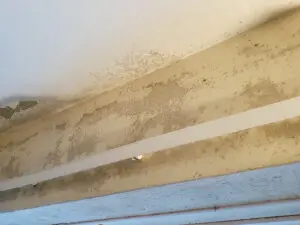Understanding Mould to Effectively Treat Housing Association Properties
Housing associations have a fundamental responsibility to provide tenants with safe homes to live in. When damp and/or mould appears in housing association properties, prompt and effective resolution is imperative to prevent danger to the health and wellbeing of tenants.
Where issues with damp or mould arise, or concerns are raised by tenants, it is vital that they are taken seriously. Housing associations will want to make sure they understand the prevalence of these issues across their stock and take steps to resolve the root cause of the problem and prevent it reoccurring as far as practicable.
Basic Mould Facts
Mould is a type of fungi that reproduces through airborne spores which can survive extremely harsh weather conditions and spread easily over large areas. Mould spores exist everywhere in the outdoor environment and can get indoors through open doors or windows or attached to clothes or shoes. Once the mould spores get into the property, they will await the right conditions to start developing.
Mould thrives in warm, humid, or damp conditions; with condensation and damp within properties being a perfect breeding ground for mould to thrive. Tenants’ homes provide an ample food source (including all kinds of organic materials such as wood, paper, leather, fabric and upholstery, grout, paint, insulation materials, carpet, etc.), so as soon as there is any source of moisture, the mould spores will begin to reproduce and spread.
This white paper provides an overview of the 7 key mould facts for housing associations, with the aim of informing, guiding, and supporting safe and effective mould remediation.
1. Different moulds thrive with varying levels of moisture
All moulds need moisture but some need more than others. Growth of mould and other micro-organisms will naturally occur if moisture is consistently present for a couple of days. The types of moulds that grow are determined by the level of moisture, usually referred to as the ‘water activity’, and it affects the order in which different categories of moulds appear. The first moulds to appear are referred to as the primary colonisers, the second group as secondary colonisers and the third group are tertiary colonisers.
Primary Colonisers:
The primary colonisers are capable of growing at water activities below 0.85. This group may include Alternaria citri, Eurotium amstelodami, Aspergillus candidus, Aspergillus glaucus, Aspergillus niger, Aspergillus penicillioides, Aspergillus repens, Aspergillus restrictus, Aspergillus versicolor, Paecilomyces variotii, Penicillium aurantiogriseum, Penicillium brevicompactum, Penicillium chrysogenum, Penicillium commune, Penicillium expansum, Penicillium griseofulvum, and Wallemia sebi.
Secondary Colonisers:
Secondary colonisers grow best at water activities of 0.85 to 0.90. Secondary colonisers may include Aspergillus flavus, Cladosporium cladosporioides, Cladosporium herbarum, Cladosporium sphaerospermum, Mucor circinelloides, and Rhizopus oryzae.
Tertiary Colonisers:
At water activities greater than 0.90, tertiary colonisers appear. These may include Alternaria alternata, Aspergillus fumigatus, Epicoccum spp., Exophiala spp., Fusarium moniliforme, Mucor plumbeus, Phoma herbarum, Phialophora spp., Rhizopus spp., Stachybotrys chartarum, Trichoderma spp., Ulocladium spp., Rhodotorula spp., Sporobolomyces spp., and Actinomycetes.
2. There are thousands of different species of mould
There are thousands of different species of mould (some of which are mentioned above) but only a handful are commonly found in UK properties. Some strains of mould are more harmful than others and can be found in a variety of colours. It can be difficult to identify exactly which strain of mould is growing and how harmful it is, so it is best practice to have a zero-tolerance approach to mould and act quickly to treat affected areas before it spreads. Some of the most common types of mould that grow in UK homes include:
- Aureobasidium pullulans. Aureobasidium pullulans requires high levels of available water to grow; it is commonly found growing indoors on surfaces that are continually damp, especially in bathrooms and kitchens, on shower curtains, tile grout, windowsills, and frames. This fungus can grow on and damage interior painted surfaces that have a constant relative humidity of at least 75%. A British study revealed that commonly used pillows contain a substantial load of many species of fungi, including Aureobasidium pullulans which was present in 6 of the 10 studied samples.
- Eurotium herbariorum. Eurotium herbariorum is found on damp gypsum board and other building materials including floor, carpet and mattress dust. E. herbariorum can provoke allergic reactions and were found that, along with E. amstelodami, C. globosum and A. fumigatus, in homes of asthmatic children and are elevated in moisture-damaged and referenced schools where children were symptomatic.
- Aspergillus versicolor. Aspergillus versicolor is a slow-growing, filamentous fungus, commonly found in damp indoor environments and on food products. It has a characteristic, musty odor associated with mouldy homes and is a major producer of the hepatotoxic and carcinogenic mycotoxin sterigmatocystin. Common symptoms associated with contact with this can include fatigue, headaches, poor memory, abdominal pain, and vertigo, but may also cause many different types of ailments and can contribute to many different chronic illnesses. More on the effect of Mycotoxins can be found later in this white paper.
- Cladosporium sphaerospermum. Cladosporium, a well-known trigger for asthmatic attacks, is one of the most widespread moulds. In an indoor environment, Cladosporium species occur as secondary wall colonisers, appearing after the primary ones such as Aspergillus versicolor and are very common on wet building material (e.g., gypsum board, acrylic painted walls, wood, wallpaper, carpet and mattress dust).
- Stachybotrys chartarum. Stachybotrys chartarum is also known as black mould or toxic black mould. It is a species of micro fungus that produces its reproductive spores (conidia) in slime heads. It is most often detected in cellulose-rich building materials, such as gypsum-based drywall and wallpaper, from damp or water-damaged buildings. Stachybotrys chartarum is mostly observed in damp buildings/homes, with its development often resulting from water damage. Several different moulds have a black appearance (Stachybotrys chartarum, Cladosporium sphaerospermum, Alternaria alternata) and have large differences in associated health risks, so seeing a black mould will not necessarily mean Stachybotrys chartarum is present. Stachybotrys chartarum produce Mycotoxins that can have serious health implications, more on Mycotoxins’ effects can be found later in this white paper.
3. Mould develops very quickly and can’t always be seen
Mould can develop on a damp or moist surface within 48 hours and can often remain hidden until the spores have already affected properties, with the potential to cause damage before it is visible.
Mould and its spores are microscopic and so hard to spot. Mould can start to grow inside walls, behind leaky appliances; within insulation; in crawl spaces, or behind wallpaper and, as mould doesn’t need light to grow, it can be at an advanced stage of development when it is found. It is possible to smell that mould is present as it can produce a musty and damp odour, causing the room to smell earthy.
4. Mould isn’t the same as mildew
Many people use the two terms interchangeably, causing some confusion about their differences. While mould and mildew are both types of fungus, they are actually two separate species. The main difference between the two is that mildew is a surface fungus that can be cleaned with commercially available cleaning products, while mould can penetrate surfaces and will likely require professional cleaning products, safetywear for the person conducting the remediation as well as addressing the underlying causes of the mould growth.
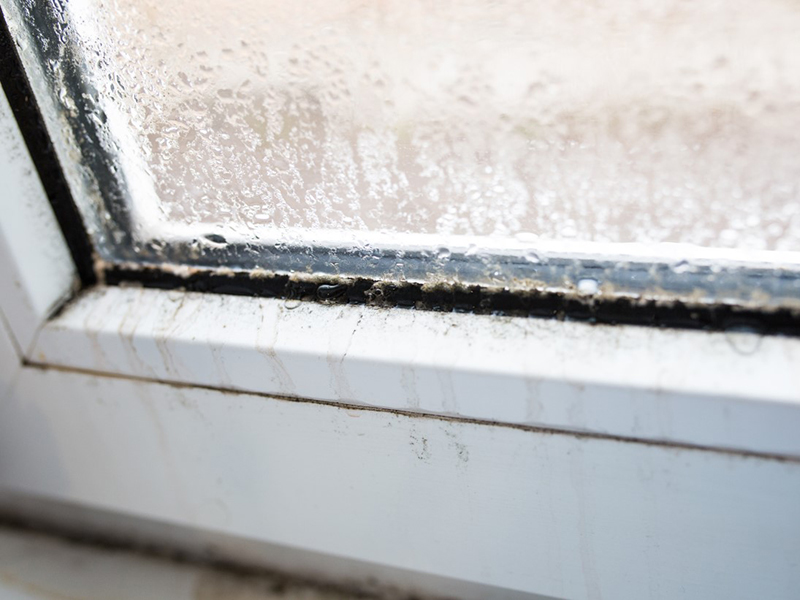
How to Identify Mildew:
Mildew is flat, looks grey or white, and has a dry or powdery texture. If in doubt, consult a damp and mould expert.
5. There are 3 types of damp that can lead to mould developing
The root cause of damp or mould in properties can vary and, in some complex cases, there may be multiple causes. Mould can arise in areas where water is coming into the property from outside (rising or penetrating damp) or in areas where moist, warm air, hits cold surfaces (condensation). To successfully tackle mould growth, the causes of the moisture build up should be addressed. Below are details about these three types of damp, how to identify them and possible causes.
Rising Damp
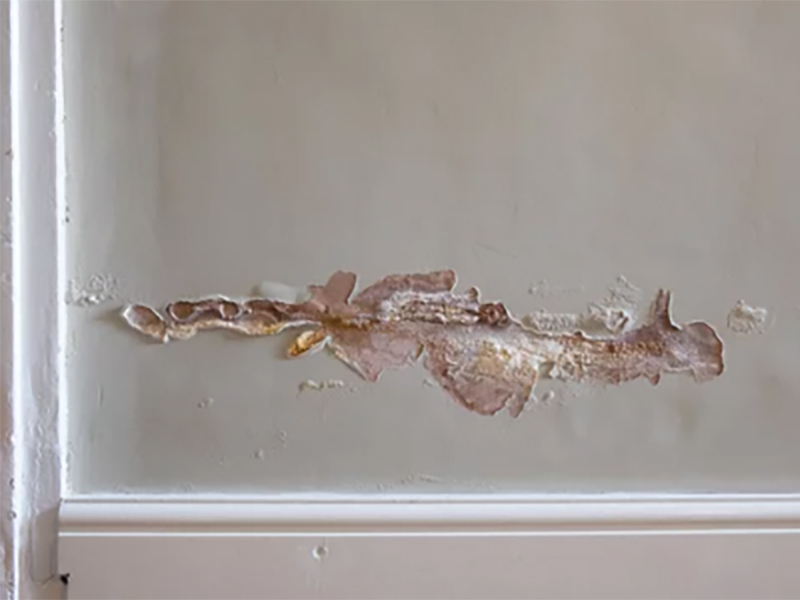
How to Identify Rising Damp:
- Water marks rising up to 1.5m from ground floor level
- Peeling wallpaper or flaking plaster
- White salt crystals
Possible Causes of Rising Damp:
- Defects in the foundation
- Debris in the wall cavity or subfloor void
- Internal or external renders/plasters overlapping the DPC
- External ground levels being raised above the DPC
- Inappropriate insulation material in the cavity
- Solid floors
- Intersecting masonry structures/abutting garden walls
Penetrating Damp
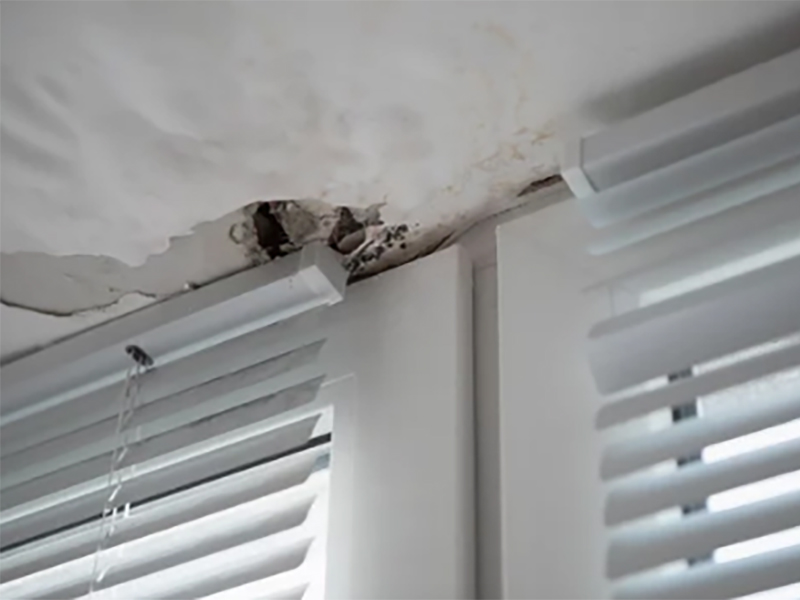
How to Identify Penetrating Damp:
- Isolated patches of damp/mould growth on walls or ceilings
- Wet or dried/staining on walls or ceilings, areas where a leak is or has occurred
- Damp patches on chimney breasts
- Green or white marks on brickwork
Possible Causes of Penetrating Damp:
- Blocked or overflowing guttering/downpipes
- Roofing defects – missing tiles, lead flashing coming away or missing
- Issues with seals around windows or doors
- Cracks in walls
- Leaking or burst pipes
- Chimneys not being capped off
- Inappropriate insulation material in the cavity
Condensation
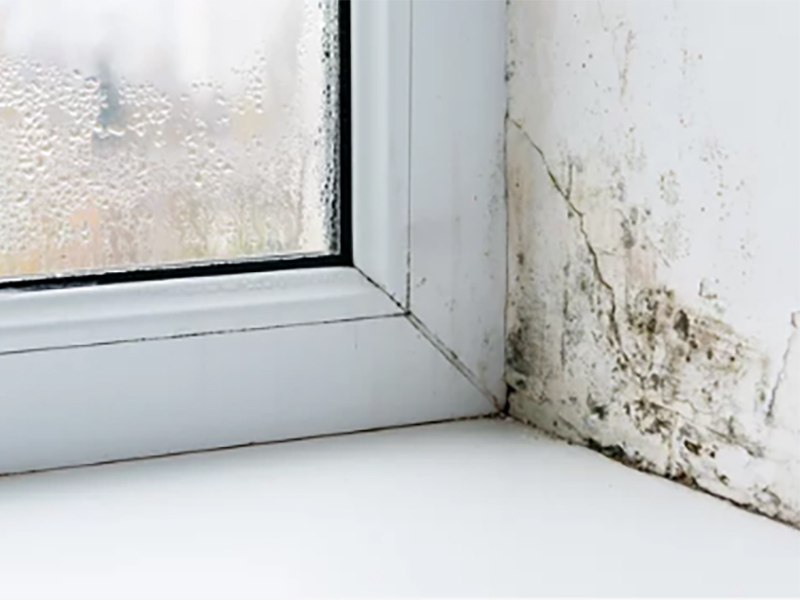
The most common cause of mould forming is condensation. Condensation occurs when humid air touches a cold surface. Condensing moist air on cold surfaces such as windows and walls can lead to damp patches on walls, ceilings and other cold surfaces which in turn create the conditions for mould to form. While condensation is linked to daily activities that produce moisture (such as bathing, cooking and drying clothes), tenants should be able to complete these activities without being blamed for damp and mould developing. As the Housing Ombudsman in England has noted, homes should be fit for modern living.
How to Identify Condensation:
- Water collecting on the inside of windows or on the window-sill
- Rotting and peeling wall paper
- Mould growing on clothes and other fabrics
- A strong musty smell
Possible Causes of Condensation:
- Poor ventilation
- Poor insulation (windows & walls)
- Excess moisture in the air
6. Mould exposure can affect health of tenants
It is a proven fact that prolonged exposure to mould may cause a variety of allergy symptoms and other serious health issues. The effects of mould exposure can vary considerably from one person to the next, with young children, pregnant women, elderly people, asthma suffers and individuals with chronic diseases and weaker immune systems being most at risk. Impacts on health can vary from mild allergic symptoms to severe respiratory problems and even ‘Sick Building Syndrome’. It is essential that housing associations take a proactive approach to not only address the mould issue, but also the underlying damp issues that are creating a mould-friendly environment.
Symptoms of Exposure to Mould can Include:
- Chronic fatigue
- Headaches
- Dizziness and disorientation
- Sneezing, runny nose, or nasal/sinus congestion, infections or chronic sinusitis
- Eye irritation such as itchy eyes, blurry vision, red, or watery eyes
- Throat irritation such as coughing, wheezing and respiratory problems.
- Inflammation of the lungs and asthma attacks
- Skin irritations and rashes
- Fever
- Nausea
- Insomnia
- Depression
Toxic black mould, in particular, may have very serious long-term health effects. It can cause sinus infections and inflammation of the lungs, whereas other strains of green mould can cause bronchitis and even pneumonia if left untreated. Mycotoxins that can cause a number of circulatory symptoms and vascular problems when inhaled. In some cases, exposure to high levels of mycotoxins can even be fatal, as in the tragic case of Awaab Ishak.
7. Mould is not the tenant’s fault
When the mould is the result of a maintenance issue or structural problem in a rental property, the responsibility lies with the landlord. Landlords must also act to address the mould in line with the Social Housing Regulation Bill (more information and link below).
Mould doesn’t grow overnight, so encouraging your tenants to report any concerns and looking out for any signs of damp or mould during inspections should mean that any damp or mould issues are caught early and can be treated more easily. Making your tenants aware of how mould and mildew can form can help them to manage moisture within their homes, but make sure you are addressing any persistent issues caused by inadequacies of the building outlined in FACT 5 (‘There are 3 types of damp that can lead to mould developing‘) above.
Blaming your tenants’ living habits (drying clothes, cooking, bathing) is no longer an acceptable excuse to leave them in damp and mouldy living conditions. To quote the Housing Ombudsman’s Spotlight Report on Damp & Mould:
Where the cause of damp and mould is non-structural it can be too simplistic to blame residents for drying their laundry on radiators if there is no space in their home for a tumble dryer or the weather is poor, other than those residents fortunate enough to have outdoor space. Occupancy factors do not mean that the landlord has no responsibility, and landlords should recognise that some homes were not designed with modern living in mind. Landlords should take reasonable steps in partnership with residents in these circumstances including considering improving ventilation or other appropriate measures.
Social housing landlords’ legal obligations on mould management are changing. An amendment to the Social Housing (Regulation) Bill, is in its final stage (consideration of amendments) and ‘makes provision about the regulation of social housing; about the terms of approved schemes for the investigation of housing complaints; and for connected purposes‘. In terms of mould management, this amendment, called ‘Awaab’s Law’, requires landlords to fix reported health hazards within specified timeframes and is due to become law before the end of 2023.
STAY INFORMED
To read more about your obligations as a Housing Association, see our helpful article here. You can find further useful resources below or get in touch to discuss PWS’ ‘Mould Kits’ and respiratory equipment advice to keep your staff safe during mould remediation.
